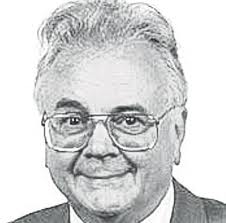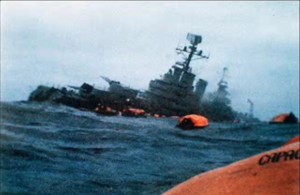Sound Archive:
Ken Coates: Use of Nuclear Weapons
Ken Coates chaired the Bertrand Russell Peace Foundation, wrote loads of books about socialism, and later became a Labour party MEP.
Transcript:
… nuclear free zones, except to stress that this is a central problem for the future, not only of this country, but of the world. That if we allow a nuclear free zone to be violated, then we do jeopardise far more than the secure future of the two contenders in this conflict.
Now let us then briefly look at what would happen under the Treaty if it were to be violated. And the argument there is quite complex, but I think I can simplify it by explaining that countries outside Latin America can endorse the Treaty under one or both of two additional protocols.
And these two protocols apply in a nutshell to colonial powers holding territories in South America but resident outside the continent in the first case, and to Nuclear Powers in the second case. So the British Government falls into both categories.
Now the Argentine Government did make a complaint that the British Government had violated the Treaty by sending the Conquerer, which is a nuclear-powered Submarine, into the area, and by sinking the Belgrano through its agencies. And that complaint has been widely discussed and normally dismissed, because the terms of the Treaty can be argued to exempt weapons which are propelled by nuclear fuels from the category of weapons which are banned from the Zone under the Treaty.
The Treaty is defined in such a way as to give the impression that it only excludes uncontrolled nuclear explosions and that nuclear propulsions are legitimate. Lawyers will argue about that for quite some time, because it is arguable that the use of nuclear propulsion, in a submarine which is bent upon destruction could be included within the range of prohibitions that the Treaty establishes. And that’s a technical question which it seems to me to be worth professional attention.
But of course the real question is is not whether or not nuclear submarines entered the area, the real question is whether nuclear weapons entered the area? And before we can determine that, we have to see that there are two area which could be covered under the Treaty.
If Britain interprets its signature to the Tlatelolco Protocol, as being the signature of a Colonial Power, it could argue that only the Territorial Waters then existing in the immediate area of the Falkland Islands were prohibited to nuclear weapons. If Britain interprets its signature to Protocol 2 of the Treaty as a Nuclear Power, as being the governing Protocol, then the area in question is enormously wider because the Treaty defines a vast area of the South Atlantic as falling into the territory which is guaranteed by it’s terms.
In fact they simply divided the Atlantic Ocean down the middle, and not only the Falkland Islands, but a wide measure of of many hundreds of square miles of sea to the East of the Falkland Islands would fall securely within the Prohibited Area into which nuclear weapons must not be brought.
So that is the problem we are facing. And then we have the difficulty about the evidence. And it may be that some of those who are in a much better position than I am to know what was happening, whose inquires are further advanced, can answer some of these questions far more satisfactorily than I can.
There are reports to the effect that the British Fleet steamed southwards in a vast hurry in a manner which made it impossible for it to divest itself of Nuclear Weapons before it arrived in the South Atlantic. As far as I can see these reports begin in The Times in late 1982, and are then picked up and repeated and confirmed by other sources. They are reported in a study by the Stockholm International Peace Research Institute, where these issues are discussed in a very balanced manner.
Tam Dalyell seized on these reports and conduced one of his persistent inquires along this dimension and to the best of my knowledge no satisfactory answers have been given to the questions which he raised. Tam of course was not merely dependent on the media for his sources of information, and maybe he can divulge some more about this matter which is not yet on the record.
What is specifically said and was stated by Tam Dalyell in his first book on this question is that the ship HMS Sheffield was sunk whilst carrying a large arsenal of nuclear depth charges which, he claimed, where standard issue for ships of that class. Subsequently this argument has become more complex and has provoked some denials from people who may not be qualified to issue denials.
In a nutshell the Swedish Merchant Fleet provided two ships under the general family name of Stenor, which went to the South Atlantic and which after the war were retained to salvage something from HMS Sheffield. And it was reported in the pacifist press in Sweden that they were salvaging these nuclear weapons.
The New Statesman, a Duncan Cambell inquiry, investigated these stories, and reported that they were not found. Duncan Cambell believed that the Stenor ships were searching for code books which had been sunk when the ship went down. I can’t throw any light on this question. It does seem to be perhaps a little strange to go to such enormous lengths to retrieve code books, however important that they may be, because most people might think that they would be secure in the place to which they had been consigned.
I only raised the question because I think that it is so important that it should be adequately answered; that, it seems to me, we should go on asking it until it is.
Now of course there have been a number of denials, the British government was quizzed by the enforcement body which polices the Tlatelolco Treaty, to which complaints were made, not only by the Argentine Government but also by Panama. And denials were made. But the denials were blanket denials which fall uneasily between the areas I have just defined.
First of all the Government always insisted that it never answered questions about whether its ships were nuclear armed or not, and that has been repeated at various intervals. Secondly, specifically, it has been said that the Government never breached it’s obligations under the Treaty of Tlatelolco. But there remains a vast ambiguity because the Government did not in saying this specify which Protocol it was obeying; whether that which would respect a 3 mile territorial limit around the Falkland Islands, or whether that which would be much wider.


“What is specifically said and was stated by Tam Dalyell in his first book on this question is that the ship HMS Sheffield was sunk whilst carrying a large arsenal of nuclear depth charges which, he claimed, where standard issue for ships of that class. Subsequently this argument has become more complex and has provoked some denials from people who may not be qualified to issue denials.”
We now know this to be utterly untrue: the nuclear weapons carried by Sheffield, including nuclear depth-charges, had been unloaded in mid-April. It was Dalyell who was “not qualified” to talk on the subject, yet still did in an effort to smear the government.